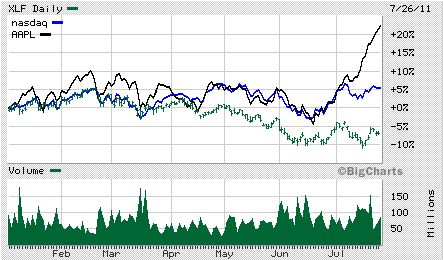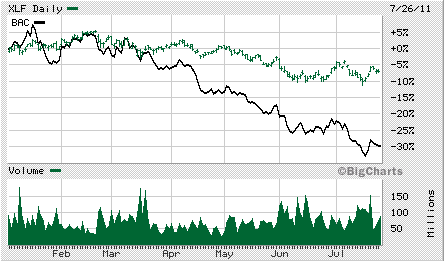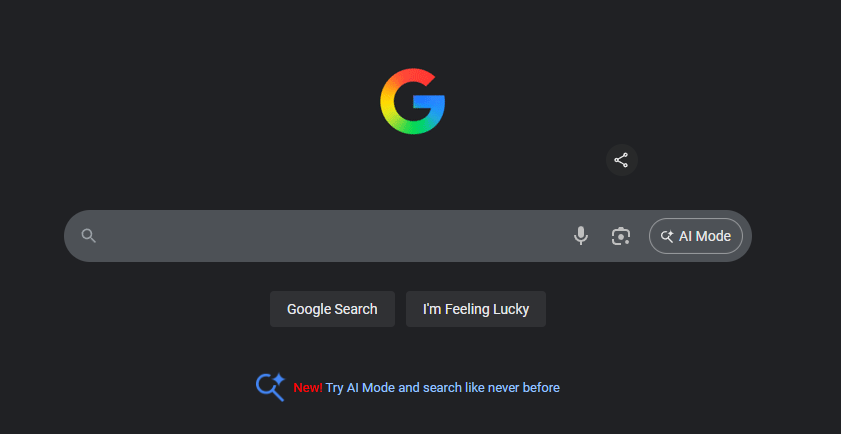Next week, I’ll be trading out one short for another…

One of my mentors used to say that traders who use exchange-traded funds are lazy. Because when you’ve done the “top down” analysis — looking at a sector and how it fits into the economy — then you’ve got your starting point. After that, you need to dig into the actual companies in that industry, doing “bottom up” analysis — looking at a company’s specific fundamentals and positioning.
Now obviously, that logic doesn’t apply to our gold (GLD) and silver (SLV) ETF shorts, because those are metals and not companies. And it doesn’t apply to our PowerShares DB Agriculture ETF long (DBA), which represents a basket of commodities like cotton, sugar and corn. But what about that Select Sector SPDR-Financial short (XLF) that I put in the Revolution Investing portfolio last September and I’ve been short myself this year to get us short exposure to the too-big-too-fail banks?
While our top down analysis on the banking sector has been dead on, the XLF has indeed been drastically underperforming the broader stock market in general and can’t even come close to the returns we’ve had in our App/Smartphone/Tablet Revolution stocks. Take a look at this year-to-date chart of the XLF compared to the Nasdaq Composite and our long-time favorite Apple:

You can see that the banking sector has been a great short hedge for our aggressive approach in tech, since our tech has been through the roof while the banking stocks have faltered. But you know what? I’m really disappointed in myself for having been “lazy” enough to just stop when I got to the top-down analysis that the banking sector would underperform the rest of the market.
As I’d called that piece when I initiated the XLF short — “Banking sector not invited to the rally” and it was all about how the banks were facing serious problems with the mortgage fraud debacles and their robosigning problems. And also I pointed out that the government has been doing everything it can to help the banks with trillions in new stealth welfare programs for the banks and extend-and-pretend policies. And when things are as good for the banks as they can get — well, it’s probably time to short them.
But doggoneit, if we had actually taken it a step further and targeted Bank of America specifically since it was exposed to those issues more than any other bank at the time instead of the XLF in general, we would have had some huge gains. Take a look at this year-to-date chart of the XLF vs. BAC:

BAC hasn’t just underperformed the rest of the market, it’s been crushed, down nearly 25% since we pointed out how badly it was positioned in this ongoing banking mess. BAC is probably still in trouble and if it needs to raise any capital any time soon, (which the market appears to be signaling), it could really end up in a vicious cycle. But the market has indeed been sniffing out the problems at BAC and especially in its mortgage servicing units and their CountryWide divisions. So I’ve got a different company that’s somehow been given mostly a free-pass despite their having just as much exposure to the same practices and programs and problems that BAC does. We’re tallking about Wells Fargo.
Wells Fargo seems to maintain that it is a cleaner institution than other mortgage originators and servicers. I’m not sure how they get the public and especially their investors convinced when faulty foreclosures, robosigning, fabricated documents and all these things we’re seeing people freak out about at Bank of America, Citigroup and others … but therein lies our opportunity. Indeed, put another way, you might consider Wells to be “the remaining Lehman” of the remaining TBTF banks.
WFC is proportionately more heavily exposed to residential real estate than the rest. It also appears to me that this company has been as aggressive in engaging in under-reserving for loan losses as anybody in the industry since the government bailed these guys out and started allowing such unrestrained flexibility in how these companies recognize the reality of their asset values.
So here’s the trade. Monday, when I get back from my trip, I’ll be closing out the XLF short and replacing it with the WFC.
And mea culpa for missing the BAC trade last year!




